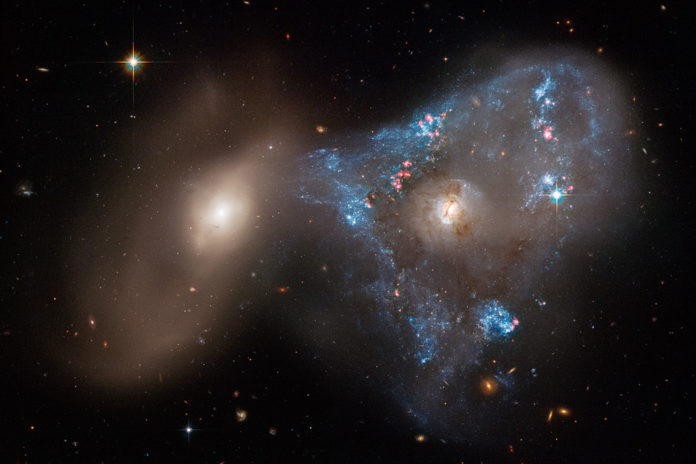A new Hubble image shows an unusual triangular-shaped star-birthing frenzy fueled by a spectacular head-on collision between two galaxies. The duo of colliding galaxies is Arp 143, which contains two interacting galaxies: spiral galaxy NGC 2445 at right and NGC 2444 at left.
NGC 2445 is a star-forming spiral galaxy, where thousands of stars are bursting to life. It is enriched in gas, fuel for star formation. However, it hasn’t yet escaped the gravitational clutches of its partner NGC 2444.
The pair appears to be involved in a cosmic tug-of-war, which NGC 2444 seems to be winning. At the same time, the galaxy NGC 2444 is pulling gas from NGC 2445, forming the oddball triangle of newly minted stars. It is likewise liable for yanking taffy-like strands of gas from NGC 2445, stirring up the streamers of young, blue stars that seem to form a scaffold between the two galaxies.
These streamers appear to be a wave of star formation that started on NGC 2445’s outskirts and continued inward. The streamers’ stars were formed approximately 50 million and 100 million years ago. However, these stars are being left behind as NGC 2445 continues to pull slowly away from NGC 2444.
Astronomer Julianne Dalcanton of the Flatiron Institute’s Center for Computational Astrophysics in New York said, “Simulations show that head-on collisions between two galaxies is one way of making rings of new stars. Therefore, rings of star formation are not uncommon. However, what’s weird about this system is that it’s a triangle of star formation. Part of the reason for that shape is that these galaxies are still so close to each other, and NGC 2444 is still holding on to the other galaxy gravitationally. NGC 2444 may also have an invisible hot halo of gas that could help to pull NGC 2445’s gas away from its nucleus. So they’re not completely free of each other yet, and their unusual interaction is distorting the ring into this triangle.”
Near the center of NGC 2445, stars are no more than 1 million to 2 million years old. Hubble captured some individual stars, which are brightest and most massive. The blue clumps appearing in images are the groupings of stars, whereas the pink blobs indicate giant, young star clusters still enshrouded in dust and gas.
The gravitational tussle of NGC 2445 is responsible for the odd shape of NGC 2444. The galaxy contains old stars and no new star birth because it lost it’s gas long ago, well before this galactic encounter.
Elena Sabbi of the Space Telescope Science Institute in Baltimore, Maryland said, “This is a nearby example of the kinds of interactions that happened long ago. It’s a fantastic sandbox to understand star formation and interacting galaxies.”
